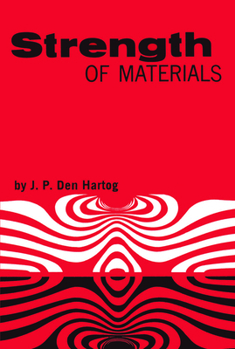Strength of Materials
Select Format
Select Condition 
Book Overview
Among introductory texts on the strength of materials, this work is particularly distinguished. It was originally developed by Professor Den Hartog to meet the needs of engineering students at M.I.T. for a sound yet lucid first course in strength of materials. As such it has also enjoyed wide popularity in engineering schools throughout the world.
But the book was remarkable in a number of other ways, so that it has become one of the favorite refresher and reference works for engineers as well as a popular self-study text. Perhaps the chief reason for this is that in addition to all the customary elementary material on the subject (i.e., clear instructions to the fundamentals of tension, torsion, bending, compound stresses, deflection of beams, etc.) it also contains a considerable amount of more advanced material concerning methods of great practical value to working engineers which are not usually included in introductory texts. This material is presented in starred sections (which may be omitted on a first reading without interrupting the flow of the presentation) and includes a full treatment of the Mohr circle and its application to the determination of moments of inertia and strains as well as stresses; a lucid elementary presentation of the theory of the center of shear; and one of the few elementary presentations of the theory of the center of shear; and one of the few elementary discussions of the "Myosotis" method of calculating beam deflections, a method which often possesses considerable advantages over the more usual methods involving moment-area or the differential equation of bending.
Other material not usually found in elementary texts but which are frequently of great value to the practicing engineer are the discussions of the statically indeterminate truss, reinforced concrete, plastic deformations, thick-walled cylinders, thick curved bars, Maxwell's Reciprocal Theorem, and photoelasticity.
In all sections, both general principles and concrete applications are given. Another feature which readers have found unusually helpful is the 85-page section of 350 problems which gives the student practice in techniques and further illustrates applications. All problems are complete with answers.
But the book was remarkable in a number of other ways, so that it has become one of the favorite refresher and reference works for engineers as well as a popular self-study text. Perhaps the chief reason for this is that in addition to all the customary elementary material on the subject (i.e., clear instructions to the fundamentals of tension, torsion, bending, compound stresses, deflection of beams, etc.) it also contains a considerable amount of more advanced material concerning methods of great practical value to working engineers which are not usually included in introductory texts. This material is presented in starred sections (which may be omitted on a first reading without interrupting the flow of the presentation) and includes a full treatment of the Mohr circle and its application to the determination of moments of inertia and strains as well as stresses; a lucid elementary presentation of the theory of the center of shear; and one of the few elementary presentations of the theory of the center of shear; and one of the few elementary discussions of the "Myosotis" method of calculating beam deflections, a method which often possesses considerable advantages over the more usual methods involving moment-area or the differential equation of bending.
Other material not usually found in elementary texts but which are frequently of great value to the practicing engineer are the discussions of the statically indeterminate truss, reinforced concrete, plastic deformations, thick-walled cylinders, thick curved bars, Maxwell's Reciprocal Theorem, and photoelasticity.
In all sections, both general principles and concrete applications are given. Another feature which readers have found unusually helpful is the 85-page section of 350 problems which gives the student practice in techniques and further illustrates applications. All problems are complete with answers.
Format:Paperback
Language:English
ISBN:0486607550
ISBN13:9780486607559
Release Date:June 1961
Publisher:Dover Publications
Length:352 Pages
Weight:0.79 lbs.
Dimensions:0.7" x 5.7" x 7.8"
Customer Reviews
2 ratings
Probably the best book on strength of materials
Published by Thriftbooks.com User , 19 years ago
This is the best book on mechanics of materials I have come across. Much more mathematical rigor than similar books by Gere and others. I read this book as an undergraduate and it put me at the top of the class. Of particular note is the Myosotis Method in the section on deflection of beams. This extremely useful method is very powerful, and has been abondonded in most new books becuase of computer software now available. Also has the best treatment of Castigliano Theorem. This book is a must have for any engineer concerned with materials. If your looking for a more advanced book, Advanced Strength of Materials, by the same offer is also very good, but outdated. It does have a very good treatment of shell theory. Better than a good amount of the books on theoretical elasticity that I own. Simply; good author; good book.
Clearly written book that is still good.
Published by Thriftbooks.com User , 24 years ago
Both books on mechanics of materials by Den Hartog are remarkable. All the questions have answers, the writing is clear and to the point. In this book, he gives the method of Myosotis to calculate the deflections of beams. Although such material is outdated, it does illustrate an elegant way of solving beam deflection problems. Today, many problems are being solved by brute-force computer methods. (Just make an FE mesh!!) Read this book even though it will not teach you anything new, if only like a novel.





